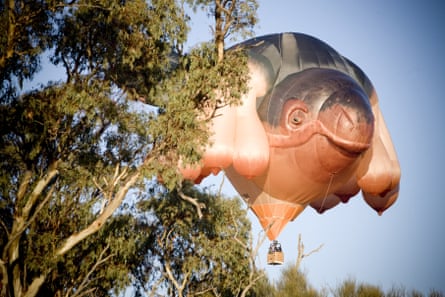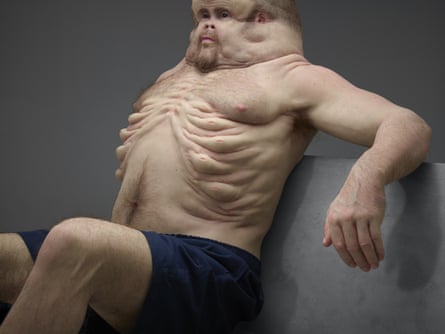Walking through Patricia Piccinini’s Melbourne studio is more like wandering through a cabinet of monstrous curiosities than visiting an artist’s workspace.
Observed within: a beast nursing a human child at her breast. Miniature anatomical models. Organic forms mouthing soundless words from the walls. Boxes and boxes of feathers. The severed head of a mannequin child upon a table. An immobile bird of prey made entirely from hair. A baby fused with an egg.
The resemblance of these rooms to a zoology lab or old surgeon’s college is unsurprising; Piccinini tells me she taught herself to draw in an anatomy museum. In a space like that, she says, hers was the advantage: “The models always remained still.”’
Since then, the multidisciplinary Australian artist has attracted global renown for figurative works that render fantastic, hybrid-human creatures in such anatomic detail that their stillness seems their most unnatural feature. This year, two of Australia’s major galleries have announced separate exhibitions of the artist’s strange, motionless menageries: Brisbane’s Gallery of Modern Art are staging the most comprehensive retrospective of her work to date next year; and later this month, Piccinini will have seven works at the National Gallery’s Hyper Real exhibition in Canberra.
While her creatures may allude to something orphic and arcane, Piccinini’s own framework remains as observational and material as a dissecting room.
“I like 19th century social realism,” she says. “[They depicted] how the Industrial Revolution had an effect on the everyday people. I’m interested in the same thing that’s happening now, in how technological innovation is changing the way that we see the body.”
Piccinini’s explorations of biology’s potential for change led the New York Times to hail her “sculptures of life forms that don’t exist”. Over the last few years her unique, three-dimensional monsters made of parts both familiar and strange have made their way into collections across with world, as well as into the Australian popular imagination.

The infamous Skywhale – a titanic, 100-foot-long hot air ball with ten pendulous breasts and a friendly face – first floated over Canberra, commissioned for the city’s centenary celebrations in 2013, before travelling as far afield as Japan and Ireland.
Last year, the Transport Accident Commission invited the artist to propose what the human body would have to look like in order to resist a high-impact car crash. The result was “Graham”: a thick-necked survivor with a reinforced skull cavity and sacks of air across his chest. Graham made international news.
They are but two amongst Piccinini’s many unsettling mutations of human and animal forms. Her Madonnas are not clothed for piety but brazen and naked, half-ape, bristling with hair. Babies in swaddling have adult faces and snouts. Nature’s expected laws of delineation – defining scales from skin, bones from feathers, sacs from follicles – are collapsed, all rules rewritten.

What’s uncanny about Piccinini’s work is not that an artist’s mind can conjure such creatures. It’s that the finesse of their detail make every variegated body that she crafts seem suddenly possible.
But for Piccinini, the beasts she invents are the logical conclusion of what is possible within the ongoing material conversation between evolutionary forces and environmental ones. Describing herself as “ambivalent about technology”, her relationship to its potential is not so much dystopian as it is technical and explorative.
To create Graham, she worked with a trauma surgeon and a crash investigator. “I really listened and internalised the science of it,” she said at the time, “then I approached it in a creative way, on an emotional level.”

Juxtapositions of the scientific against the emotional are perhaps to be expected from an artist whose first university degree was in economics, at the Australian National University. The course offered her understanding of human systems, activity and phenomenons of mass behaviour – although the insight she shares with me was in learning not how the world works, “but how people think the world works”. The false perception, the artist declares, is that supply and demand drive productivity; for Piccinini, the motivation for all human productivity is desire.
It’s a conclusion expressed with the considered sincerity that defines Piccinini’s approach to her own creative process. Discussing the upcoming Hyper Real exhibition – where she will be featured alongside artists including Belinda de Bruyckere and Ron Mueck – Piccinini explains the continuing appeal of realism with articulate care.
“If you’re making art that’s the opposite of realism – which is a kind of formalism – then it’s difficult for everyday person to connect with that, because to understand formalism … you have to have a knowledge of [it] and a background in it,” she explains. “That can be alienating … whereas realism has the potential to be so inclusive. Anyone can connect to it – because it’s what they know.”

At Brisbane’s QAGOMA, the spectrum of what the artist intends as a “compassionate vision” of the body will be recognised with some scale. The Curious Affection exhibition will fill the gallery’s entire ground floor with a decade’s worth of Piccinini’s most recognisable works, as well as a bespoke large-scale new inflatable sculpture and an immersive multisensory installation.
I have my own experience of aesthetic immersion in Piccinini’s studio when she takes me into its “hair room”. In it, an assistant is sewing individual hairs into the arms of a fleshy figure frozen in the act of giving birth. Were it not got the gentle, intellectual presence of Piccinini herself, I’d be freaking out and bolting for the door.
But, of course, these are not real pieces of body or dissections of flesh; they’re instruments of a discursive project - even if the hair itself is human. As Piccinini reminds me, with some tenderness: “I use realism, but I don’t want to represent reality. I want to represent ideas.”

Comments (…)
Sign in or create your Guardian account to join the discussion